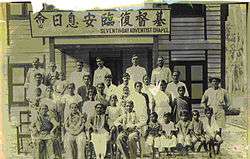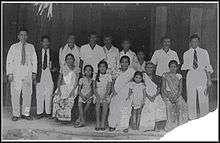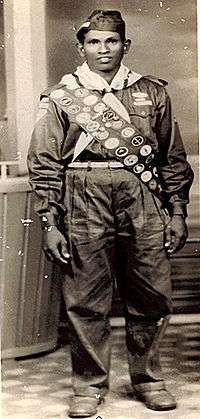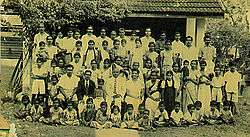Seventh-day Adventist Telugu work: Malaysia
| Seventh-day Adventist Church | |
|---|---|
| Classification | Protestant |
| Orientation | Adventist |
| Polity | Modified Presbyterian Polity |
| Leader | Ted N. C. Wilson |
| Region | Worldwide |
| Founder | |
| Origin |
21 May 1863 Battle Creek, Michigan |
| Branched from | Millerites |
| Separations |
Seventh Day Adventist Reform Movement (separated 1925); Shepherds Rod – Davidian SDAs (separated 1929) |
| Congregations |
71,048 churches, 65,553 companies |
| Members | 17,214,683[1] |
| Ministers | 17,272[1] |
| Hospitals | 173[1] |
| Nursing homes | 132[1] |
| Aid organization | Adventist Development and Relief Agency |
| Primary schools | 5,813[1] |
| Secondary schools | 1,823[1] |
| Tertiary institutions | 111[1] |
| Other name(s) | Adventist church, SDA (informal) |
| Part of a series on |
| Seventh-day Adventist Church |
|---|
 |
|
Adventism Seventh-day Adventist portal |
The Seventh-day Adventist Church[2][3] is a Protestant Christian[4] denomination distinguished by its observance of Saturday,[5] the original seventh day of the Judeo-Christian week, as the Sabbath, and by its emphasis on the imminent second coming (advent) of Jesus Christ. The denomination grew out of the Millerite movement in the United States during the middle part of the 19th century and was formally established in 1863.[6] Among its founders was Ellen G. White, whose extensive writings are still held in high regard by the church today.[7]
Much of the theology of the Seventh-day Adventist Church corresponds to Protestant Christian teachings such as the Trinity and the infallibility of Scripture. Distinctive teachings include the unconscious state of the dead and the doctrine of an investigative judgment. The church is also known for its emphasis on diet and health, its holistic understanding of the person, its promotion of religious liberty, and its conservative principles and lifestyle.[8]
The world church is governed by a General Conference, with smaller regions administered by divisions, union conferences and local conferences. It currently has a worldwide baptised membership of about 17.2 million people.[9] As of May 2007, it was the twelfth-largest religious body in the world,[10] and the sixth-largest highly international religious body.[11] It has a missionary presence in over 200 countries and territories and is ethnically and culturally diverse.[1][12] The church operates numerous schools, hospitals and publishing houses worldwide, as well as a humanitarian aid organisation known as the Adventist Development and Relief Agency (ADRA).
The Seventh-day Adventist movement in Malaysia began in 1928 and continued until 1970 amongst the Telugu workforce in the states of Perak, Selangor and Kedah. It began with Pastors Lot and Prakasham, missionaries from India. Later the work was expanded through Pr. R.J. Moses, Pr. P.G Ratham, Pr.V. Samuthram, Pr. V.N. Joseph, Pr.P. Benjamin and many others.
Background of the Telugu race in Malaysia
In the late 19th century and early 20th century, there was a significant exodus of Andhras especially from the Visakhapatnam district to the Malay Peninsula. They came as manual labourers to meet the shortage of labour in the rubber and coconut plantations, mainly owned by the British. Motivations for the migration the intolerable conditions in the Visakhapatnam district. Floods devastated the crops and the dwindling of the mercantile industry brought a lot of unemployment. Meanwhile, there was a shortage of labour in the plantations of Malaya. Therefore, in 1921, about 40,000 Andhras from India migrated to Malaya. Many settled throughout West Malaya, though the main concentration was in Lower Perak (Bagan Datoh and Teluk Intan areas), Selangor, Negeri Sembilah, and Kedah.[13]
Bagan Datoh work

Andhras that migrated to Malaya in the early 1920s were confronted with many challenges; this may have opened the hearts of the people to hear the gospel. The Seventh-day Adventist Telugu work was first established in Sungei Way, near Kuala Lumpur, in the late 1920s.
The Gospel work then expanded to Bagan Datoh in 1928.[14] The work spread with churches and companies in many places. There were about 13 stations with one worker at each station. However, after the war, the work was greatly reduced with only three stations.[15] Pastor Lot and Pastor Prakasham were among the pioneers to bring the Gospel to the Telugu population in Malaya. They are assumed to be the first missionaries to work in Bagan Datoh.
Early converts met in believers' homes for worship. Several laymen from Sungei Way helped the missionary work to flourish in Bagan Datoh. As the membership grew, Pastor William W.R. Lake (then President of the Malaya Mission), through his interviews and correspondence with the Estate manager, arranged for a temporary house of worship to be built by the estate for the believers, who were also granted Sabbath privileges.[16]
Pastor R.J. Moses

Pastor R.J. Moses came to serve the Sungei Way Telugu church in 1930s. The church grew with old members reclaimed and new ones are being added. On Sabbath, 16 December 1939, nine people were baptised. About forty members gathered to witness the baptism service.[17] Pastor Moses also visits other Telugu churches in the state of Perak. He was in Teluk Anson church encouraging believers and leading out in Harvest Ingathering.[18]
Pastor P.G . Rathnam
Pastor P.G. Rathnam came to serve in Bagan Datoh and Teluk Intan in 1936. He later worked in the Kulim district from 1941–1949. After that he returned to Teluk Intan and Bagan Datoh and remained there until 1957, when he was called to be the pastor of Sungei Way, Telegu Church.[19] Pastor C.H. Rathnam worked in Bagan Datoh briefly when Pastor P.G. Ratham was transferred to Kulim. Mr. and Mrs Prasada Rao, missionaries from India, held revival meetings in Bagan Datoh in April 1952.
On 7 April 1956, pastor T.C. Chin, president of the Malay States Mission, conducted a baptism service in Bagan Datoh church. Pastor P.G. Rathnam was excited about the baptisms and the widespread interest in religious studies.
Pastor V. Samuthram (1922–1962)
Pastor Samuthram parents are immigrants from India. They did not have any children for a long time and prayed for a child. God answered their prayers and his mother conceived him as they crossed the Indian Ocean to come to Malaysia for a better life. So they felt that it was appropriate to name him as ‘Samuthram’, which means Ocean. Pastor Samuthram heard the gospel and the Sabbath at very early age. As a teenager he took the Sabbath seriously. He kept the Sabbath against the wishes of the estate manager and attended church faithfully. At this young age he had a strong passion to do the Lord’s work. Since his parents worked in the plantation area, there were not many educational opportunities. But this did not prevent him to pursue his quest for higher education. He went to the Seventh-day Adventist school (elementary) in Singapore to learn English as a second language. He was much older than all of the students in the class. He had to marked up several subjects in a short period of time. After which, he went to Narsapur, India to pursue his theological training.
Master Guide and Churches
Pastor V. Samuthram, after returning from Ministerial training in Narsapur, was called to serve in Bagan Datoh and Teluk Anson churches in 1957. Meantime, Pastor P.G. Rethnam was transferred to Sungei Way, (Selangor) Telugu church.
Soon after his return Pastor Samuthram organised the MV society. His enthusiasm in developing this phase of work, and the honours displayed on the sash he wears, inspire young men and women to become missionary volunteers. [20]

He worked with the young people for more than a year in leading and developing the MV classes. Some of the young men are canvassing in the nearby towns. They hope to receive enough compensation to entitle them to scholarships for ministerial training in India. The young men formed a football team as “Orion Footballers”.[20]
As the membership grew and the old building began to deteriorate, there was a need for a new church. Towards the close of 1957 it was proposed that the old building be put into good shape through extensive repair. This plan of repairing the church was presenting to the manager with the estimated cost. The manager suggested of building a new church instead of repairing the present one. The estate would be happy to allotted another plot of land in a more prominent location with approximately one acre of land facing the main road. The new location was secured and the members set to work, they raised funds and cleared and levelled the land to great extent by their own labour. Finally with the donation from the Bagan Datoh estate and the Union, the church building, funitures, road and bridge was built. This church accommodates 168 people. Pastor Samuthram worked hard collecting funds for the church.[21]
On 24 October 1959 the newly erected Bagan Datoh Church was dedicated to the service of God. The invitations for the dedication were sent to many, including N.J. Cowie, Manager of the Bagan Datoh Estate, Pastors H.C. Currie, S.J. Lee from the Union; Pastor T.C. Chin from Mission headquarters. Pastor Currie preached the dedicatory sermon. There is no church of similar construction in this town.[22]
Pastor Currie and Pastor Samuthram worked tirelessly to raise funds for the church building. An Indian money lender in Teluk Intan was impressed to see a white man in town soliciting and he gave a large sum of donation for the church building. Five candidates were baptised during the dedication service.
Active laymen are ready to do the Lord’s work. Brothers V.N. Joseph, P. Benjamin, P.T. Jacob, and others later went to India for Ministerial training. There were many active laymen e.g. Philip, Ethiayah, K.S. Abraham, Y.J. Moses, P.T. Jacob, P. Moses and Israel.
Many of the active members remained faithful to the Lord. Mr. K.S. Abrabam is a retired school principal of the Tamil/Telugu school in Lower Perak. Dr. Y.J. Moses is teaching in Union College in Nebraska, USA. Pastor P. Benjamin retired from Peninsula Malaysia Mission. He served more than 30 years as pastor and later as a Departmental leader to the Telugu and Tamil churches. Pastor V.N. Joseph also served as a Pastor for about 30 years in Tamil and Telugu speaking churches respectively. Many of their off-spring are well educated and blessed.
Pastor Samuthram also conducts services in Teluk Anson in another town. He cares for the flock in Bagan Datoh in the morning and in the afternoon this church in Teluk Anson. ( The Messenger, October 1958.p. 5)
The members in Teluk Anson were meeting in a club and needed a decent place to worship. Pastor Samuthram and the members got busy looking a place for a church building. After much painstaking effort a place was located.
Confronting the Evil Spirits
Pastor Samuthram had an unusual experience confronting the evil spirits. The estate folks were told not to walk down the valley after dark from the main road from the church. They believe that some individuals were murdered and that their spirits were roaming restlessly in the valley. One day, Pastor Samuthram had an urgent matter to attend in the estate and he had to pass down the valley. He heard of the ‘spirits roaming’ story and it did not prevent him from going through that path. As he was crossing the valley, he heard a very loud screaming voice, which he believed was the evil spirits. As a man of God he fell on his kneels and prayed. He believed the angels of the Lord was on his side and without fear he continued his journey. He walked to the estate about a mile and the people told him that they too heard the loud screaming voice. After attending to his urgent need, he proceeded to walk back with a little lamp with him as it was pitch dark on the same path where he encountered God’s protection. He later shared the encounter with his wife (Swartha) and the church members. .[23]
Beautification of the Bagan Datoh Church
Pastor Samuthram and members took pride in beautifying the surrounding of the church. They were excited about the new church and many varieties of plants, scrubs and trees were planted. And it became a tourist attraction. The public would visit the church grounds and take pictures. This is the only Protestant church in that area till today.
Shockwaves
Pastor Samuthram did not have the privilege to see the completion of the Teluk Anson Church. As he was returning from Teluk Anson to Bagan Datoh he met an accident on his motor-bike on his way home. A taxi driver (Mr. Krishna) found him lying down by the road way side. He quickly picked him up and left him in the Teluk Intan district hospital. The doctors were not much hopeful about his survival, he had several serious injuries on his head and other parts of the body. He battled for his life for three days before the Lord called him home. Nobody till today is certain how the accident took place. His death brought shock waves throughout the communities in Malaysia, Singapore and as far as India. He died on 7 August 1962 at the age of 40 years and served as a pastor for about five years.[24] Brother Samuthram, pastor of the Bagan Datoh and Telok Anson Churches of Malaya Mission, was killed in a motor-cycle accident on 7 August 1962 leaving behind his wife suwartha, daughter Martha and sons Jackson (Daniel), Emmanuel, Lucas and Hendry. [25]
Pilgrimage to Bagan Datoh Church

Even though, there are not many members in Bagan Datoh church today. Many have moved to bigger cities for better opportunities. But the members have not forgotten their roots.
Every year at least once (New Year’s Day), many of them would gather to celebrate the New Year. Members believe in a special blessings to start the New Year in Bagan Datoh Church. This New Year gathering tradition is still observed.
Pastor V.N. Joseph
Pastor V.N. Joseph returned from his ministerial training in Narsapur, India and was called to serve in Bagan Datoh and Teluk Anson churches respectively in 1963.
Pastor T.C. Chin (President of Malaya Mission) visiting Bagan Datoh Church in 1964. Pastor V.N. Joseph is the newly appointed Minister.[26] Pastor V.N. Joseph served the Peninsula Mission for many years. As information is available, his ministry will reflect much work of the Sungei Way church, Selangor. He also served in Bagan Datoh, Teluk Intan, Banting etc.
Pastor P. Benjamin
Pastor P. Benjamin returned from Ministerial training from Tamil Nadu, India. Upon his return he served briefly as a chaplain in Penang Adventist Hospital. After which he was called to serve in Bagan Datoh and Teluk Intan churches respectively. And Pastor V.N. Joseph got transferred to Sungei Way Telugu Church. Pastor Benjamin worked in the two respectively churches for many years . In 1969, the two prominent Telugu pastors P. Benjamin and V.N. Joseph got together and conducted an evangelistic meetings among the Telugu-speaking people of Kuala Perak estate near Bagan Datoh. The response was overwhelming with 200 people showing up the first night of the meeting. Many came forward to accept Christ as their personal Saviour, of whom eight got baptised.[27] The members were all excited about the new souls added to the church.
Teluk Anson (Teluk Intan) Work
Mr and Mrs Prasada missionaries from India held revival meeting in the Club house, Teluk Anson on 4 April 1952. P.G. Rathnam is the local church Pastor.

The Seventh-day Adventist church in Teluk Anson was organised on 31 October 1933. The membership of the church is made up almost entirely of people of the local municipality. They held their meetings in a club house for many years through the courtesy of the club authority right up to the time when they moved to the new church building.
The club house is not the most suitable place of worship. After some effort a new location was found through the kindness of the former owner of the land Mr. Thong Park Seng, a small sub-division of the land was arranged, and the transaction was completed in the early 1961. The total cost of the church project was nearly R$30,000.[28]
Teluk Anson Church dedication 1964. It was a day of joy for the Telugu believers in Teluk Anson to be present to attend the dedication service . Now the believers have a permanent church building to worship God. Pastor C.D. Martin, Division MV secretary gave the dedicatory sermon. Brother M. Lucas from Singapore translated Pastor Martin’s sermon. Many other visitors were present especially the members from Bagan Datoh church.
In August 1966 a major evangelistic meeting was held in Teluk Anson. Pastor D.R. Guild, the Union president, joined with Pastor Benjamin conducted this meetings. The church was packed to capacity nightly for the first week as Pastor Guild presented the messages. Pastor Benjamin continued the meetings, using the Bible marking method and the ‘ It Is Written’ motion pictures. These meetings was held in Tamil to reach the Tamil speaking population.
Pastor D.R. Guild and Pastor Benjamin held a major evangelistic meetings August 1966 in Teluk Anson. (The Messenger, July–August 1966 p. 7)
See also
Footnotes
- 1 2 3 4 5 6 7 8 "Seventh-day Adventist World Church Statistics". Office of Archives and Statistics, General Conference of Seventh-day Adventists. December 2009. Retrieved 2011-09-043. Check date values in:
|access-date=(help) - ↑ SDA
- ↑ officially abbreviated Adventist "Use of the Church Name". Seventh-day Adventist Church. Archived from the original on 10 January 2007. Retrieved 11 January 2007.
- ↑ Queen, Edward L.; Prothero, Stephen R.; Shattuck, Gardiner H. (2009). 'Seventh-day Adventist Church' in Encyclopedia of American religious history, Volume 3, 3rd edition. New York, NY: Infobase Publishing. p. 913. ISBN 978-0-8160-6660-5.
- ↑ More precisely, Friday sunset to Saturday sunset; see When Does Sabbath Begin? on the Adventist website.
- ↑ "Seventh-day Adventists—The Heritage Continues Along". General Conference of Seventh-day Adventists. Archived from the original on 6 December 2006. Retrieved 17 January 2007.
- ↑ Ronald L. Numbers, Prophetess of health: a study of Ellen G. White (3rd ed. 2008) pp. xxiii–xxiv
- ↑ Seventh-day Adventist Church Fundamental Beliefs Retrieved 22 June 2011.
- ↑ http://www.adventist.org/world-church/facts-and-figures/index.html
- ↑ "Largest Religious Bodies". Adherents.com. 18 May 2007. Retrieved 30 July 2010.
- ↑ "Top 10 Largest Highly International Religious Bodies". Adherents.com. 18 May 2007. Retrieved 30 July 2010.
- ↑ "Statistical report. Annual council of the General Conference Committee, October 9–14, 2009" (PDF). 30 June 2009. Retrieved 23 March 2010.
- ↑ Naidu, Appanna. "The Three Generations of the Telugus in Malaysia". Retrieved 4 June 2012.
- ↑ Lucas, M. (January 1960). "Dedicated to God" (PDF). Southeast Asia Union Messenger. Singapore: Seventh-day Adventist Union of Southeast Asia. 10 (1): 1,2. Retrieved 10 February 2012.
- ↑ The Messenger, November–December 1956 p. 7
- ↑ The Messenger, issue January 1960:1
- ↑ Notes of Progress, February 1940 p. 2
- ↑ Notes of Progress, October 1939 p. 4
- ↑ The Messenger, March 1959, p. 2
- 1 2 The Messenger, October 1958 p. 5
- ↑ The Messenger January 1960, p. 1,2
- ↑ The Messenger, January 1960 p.
- ↑ Interviewed by Mr.K.S. Abraham, one of the pioneer's of Bagan Datoh Seventh-day Adventist work
- ↑ Interviewed by K.S. Abraham, one of the pioneer's of Bagan Datoh work
- ↑ The Messenger, September–October 1962. p. 8
- ↑ Seventh-day Adventist: 'The Messenger', 1964
- ↑ The Messenger, November–December 1969 p. 4
- ↑ The Messenger, January–February 1964 p. 2
References
- The Holy Bible, New Revised Standard Version.1996,c1989. Thomas Nelson: Nashville
- The Messenger: bi-monthly official organ of the S.D.A. of Southeast Asia union. Upper Serangoon Road, Singapore.
- Notes of Progress: Monthly official notes of the Malayan Union Mission of Seventh-day Adventists, Upper Serangoon Road, Singapore.